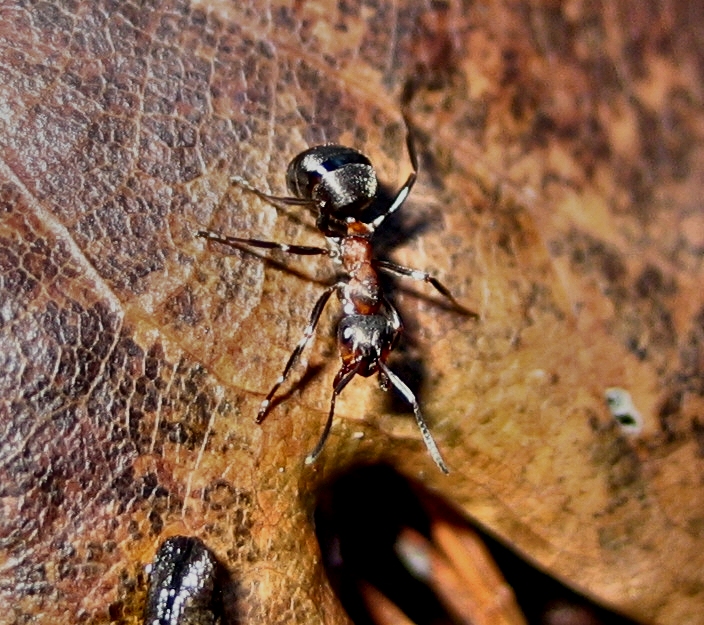- Formicinae
Taxobox

image_width = 250px
image_caption = "Formica rufa " worker
regnum =Animal ia
phylum =Arthropod a
classis =Insect a
ordo =Hymenoptera
familia = Formicidae
subfamilia = Formicinae
subfamilia_authority = Lepeletier,1836
subdivision_ranks = Genera
subdivision = See text.Formicinae is a
subfamily within the Formicidae containingant s of moderate evolutionary development.Formicines retain some primitive features such as the presence of cocoons around
pupa e, the presence of ocelli in workers, and little tendency toward reduction ofpalp or antennal segmentation in most species, except groups. Extreme modification ofmandible s is rare, except in the genera "Myrmoteras " and "Polyergus ". On the other hand, some members show considerable evolutionary advancement in behaviors such as slave-making and symbiosis with root-feedinghomoptera ns. Finally, all formicines have a very reduced sting and enlarged venom reservoir, with the venom gland, specialized (uniquely among ants) for the production offormic acid .Classification
The tribal structure of Formicinae is not completely understood. This list follows the scheme at [http://antbase.org/ antbase.org] , but there are other schemes and names.
*
Camponotini
**"Calomyrmex "
**"Camponotus" –Carpenter ant s (Global)
**"Chaemeromyrma "
**"Echinopla "
**"Forelophilus "
**"Opisthopsis "
**"Overbeckia "
**"Phasmomyrmex "
**"Polyrhachis " (Asian, African tropics)
**"Pseudocamponotus "
*Formicini
**"Alloformica "
**"Bajcaridris "
**"Cataglyphis "
**"Formica " – Wood ants
**"Polyergus" –Amazon ant s
**"Proformica "
**"Protoformica "
**"Rossomyrmex "
*Gesomyrmecini
**"Gesomyrmex "
**"Prodimorphomyrmex "
**"Santschiella "
**"Sicilomyrmex "
*Gigantopini
**"Gigantiops " (Neotropical)
*Lasiini
**"Acanthomyops "
**"Acropyga "
**"Anoplolepis "
**"Cladomyrma "
**"Lasiophanes "
**"Lasius "
**"Myrmecocystus "
**"Prolasius "
**"Stigmacros "
**"Teratomyrmex "
*Melophorini
** "Melophorus " (Australian)
*Myrmecorhynchini
**"Myrmecorhynchus "
**"Notoncus "
**"Pseudonotoncus "
*Myrmoteranini
**"Myrmoteras "
*Notostigmatini
**"Notostigma "
*Oecophyllini
**"Oecophylla" –Weaver ant s
*Plagiolepidini
**"Agraulomyrmex "
**"Aphomomyrmex "
**"Brachymyrmex "
**"Bregmatomyrma "
**"Euprenolepsis "
**"Myrmelachista "
**"Paratrechina " – Crazy ants
**"Petalomyrmex "
**"Plagiolepis "
**"Pseudaphomomyrmex "
**"Pseudolasius "
**"Tapinolepis "
*"Incertae sedis "
**"Eucharis"
**"Imhoffia "
**"Kyromyrma " (fossil :Cretaceous )
**"Leucotaphus "
**"Protrechina "
**"Tylolasius "References
* B. Bolton, "A new general catalogue of the ants of the world", Harvard University Press, Cambridge, MA, 1995.
External links
* [http://atbi.biosci.ohio-state.edu:210/hymenoptera/nomenclator.name_entry?text_entry=formicinae&Submit=Submit+Query Formicinae] at [http://antbase.org/ antbase.org]
* Kye S. Hedlund, [http://www.cs.unc.edu/~hedlund/ants/SubfamilyPages/Formicinae-print Subfamily Formicinae]
Wikimedia Foundation. 2010.
